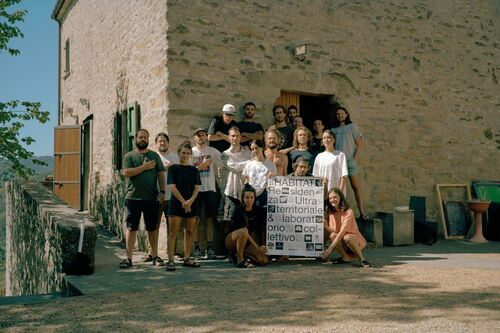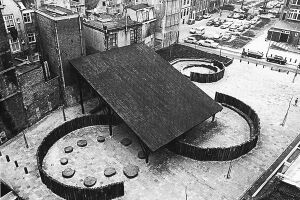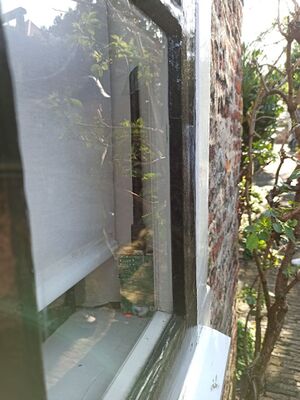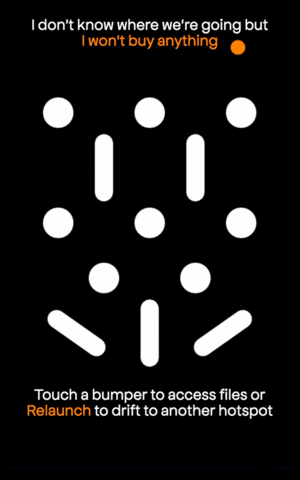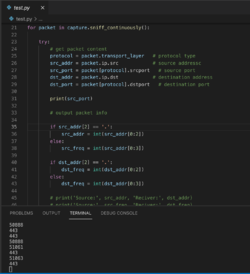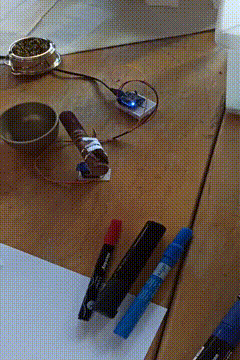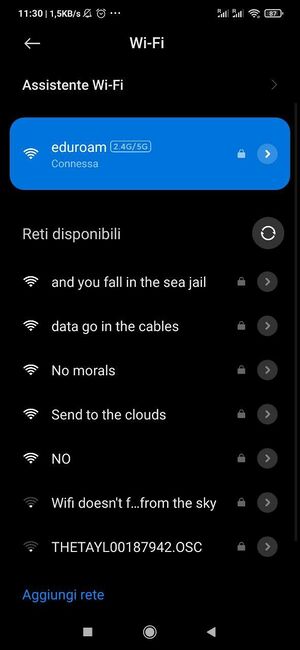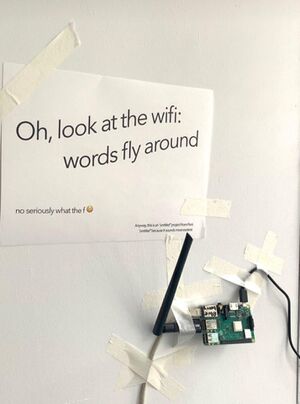Federico-project proposal
Project Proposal
What do you want to make?
This summer I was in Habitat, the residency organized by Jacopo. I spent almost a month there because I couldn't stay more than three days in my hometown, situated in the Po Valley, a valley well-known in Italy for its very foggy winter and very humid summer with quite diffused boredom.
A step back: what is Habitat?
Habitat
Habitat is a collective workshop for cultural re-activation of rural, mid-areas in Italy, as the ideal environment for artistic practices in dialogue with the territorial specificity.
Habitat is a format conceived to respond to the need for cultural revitalization of rural villages and areas, intending to resonate with their cultural heritage and local traditions as an important tool for understanding the present. While braiding in the specific pre-existent context, the project helps to define new possibilities for artistic and cultural developments – combining research, experimental approaches and the speculative power of the imagination.
The project, which takes place in the form of a program of residencies and in-site events during the summer, starts the dialogue between the cultural, architectural and the naturalistic heritage of the place with the contemporary artistic production; represented by artists who become mediators of the artistic debate within the rural-context.
The edition of summer 2021 has been placed in Ca' de Monti, Tredozio (FC).
Between the valleys that accompany the hills towards the sea, sinuously descending from the Apennines between Romagna and Tuscany, stand the Tramazzo and the Montone valleys, furrowed by the corresponding streams. The territory, as much disputed as it is still, at times unchanged - despite being peripherally annexed to the Republic of Florence since the 1400s, has always been considered linguistically and culturally part of Romagna. The villages of Tredozio, Rocca San Casciano, Portico di Romagna and San Benedetto in Alpe are just some of the ancient settlements that dot the valleys: a border, transhumance and fallow land. A generous place, which over the centuries, in the mix of Romagna culture and Florentine political, cultural and artistic influences, still manifests tangible references in the architecture and the landscape itself. The legacy and traditions accumulated over centuries of history are still manifested in ancient forests, hermitages and abbeys, castles and noble palaces, along with other seductive examples of the mixture of human ingenuity and naturalistic heritage. Tredozio (334 m s.l.m.) is a small village of 1.145 inhabitants [1], situated in the solitary valley of Tramazzo, the northernmost area of the Parco Nazionale delle Foreste Casentinesi. Going beyond Monte Busca, the road descends towards the Montone valley, where we find Rocca S. Casciano (1.763 inhabitants)[2], Portico di Romagna and San Benedetto in Alpe (745 inhabitants)[3]; Perched along the road which - making its way through the dense forests and rock walls carved by the Montone river, connects the two regions.
Something strange happen: I brought, after the first week of the residency, my violin (which I haven't played for like 10years) and my watercolors (I haven't used for 5 years). I started to play and draw daily, in different situations.
Internet was only in a room, provided by a little parabola which uses the service "Eolo", a long wifi range service.
Let's say I'm well known for the amount of time I spend in front of the computer: in Habitat, I realised I preferred just to do different stuff instead of stay in that room (a lot of people would say "of course you would!" but it's not so obvious). Also, only one cellphone provider had (bad) connection there, so most of us didn't have any kind of connection at all in our smartphones.
No, I'm not going to say that we live better without technology or start to celebrate Ted Kaczynski.
I want to say that we, this summer, experienced just another form of sociability that we are just not used to anymore - but this again is not the point - But the point is:
if we want to reactivate this area we should not push to have an internet fiber connection but we can rethink alternatives and experimental ways of connections.
After that month in Habitat, president Jacopo baptized me as Minister of infrastructures of Habitat next to the vice-president Ilaria, the grand official adviser Enrico and the Minister of the arts Lorenzo.
Everything started with the Collective Portfolio: a wireless local hotspot, an access point created with a Raspberry Pi where people could upload the projects they were doing during their stay. It was the first attempt of a (not yet there) series of self-management infrastructures for Habitat. The system fully worked but it was developed basically the last week of residency, so never really started.
Statement
Art must respond to the problem of enablement, that is, how the making of artworks enables both the maker and the viewer to think.
Thus, art production cannot be merely formal play.Art after the Machines, Mohammad Salemy [4]
Jacopo and I would work together to the final project, which would consist of the building of different infrastructures that deal with alternatives and experimental ways of connections - from a solar-powered server to an ultra-local access point, radio AM communication experiments with the neighbors, Satellite tracking studies, and esoteric performances at the 5g antenna which is at the top of the hill. (yes, there is a 5g antenna just for one operator and no cellphone works)
As Habitat, we want to provide a set of tools, local infrastructures and physical spaces (in the form of a residency) in order to promote creative production within small scale environments such as rural and remote areas, to respond to their need for cultural revitalization; intending to resonate with their resilience, cultural heritage and local traditions as an important chance for understanding the present. This ultra-territorial community-based model aims to re-create the ideal environments for a participative, cultural development, working as a fluid container for people and knowledge that lends itself to some form of response or interaction and making the place alive through the practices of all its participants (temporary and stable residents + local community + networked bubbles). It is a way to experiment new, hybrid practices and cultural communities, extremely necessary in our contemporaneity. While braiding in the specific pre-existent and micro-territorial context, the residency prompts arguments and discussions around collectivism as inherently opposed to neo-liberalist consequences on a global scale. Collectively defining and addressing new possibilities for a local, cultural-based community means establishing new forms of relations between the individual and the environment, implementing tools and infrastructures that could be appropriate for the protection and promotion of the diversity of cultural development, creative expression and supporting the spring of new values in the specific territory.
The main focus is to create a repository of tools for Habitat that could potentially be set in a similar situation.
Shape and provide the set of local tools and infrastructures for knowledge sharing, relations making and ultra-territorial publishing, as a way to bridge the local cultural environment with the world. How can this infrastructure capture, gather and turn it into forms of publishing?
It should be a playground of waves, a magic circle where we can play but we are aware of the global captivity.
The infrastructures would be thought for a new way of living in an ecosystemic manner, embracing the complexity around a place like that rural hill in Italy.
Lines
The horizontal line pushes us towards the matter
the vertical one towards the spirit.
Franco Battiato[5]
The urbanism of Habitat is completely different from the one that is present, for instance, in Milan and it's related to the architecture of the walls but also the architecture of digital (and not) infrastructures.
The first draft of the Project Proposal was mostly a pure list. I would like to keep those three points for a few reasons:
- A series of tools to dwell the territory or and the hyper-territory and or the meta-territory (ongoing-urbanism)
- A series of tools to narrate the territory or and the hyper-territory and or the meta-territory (past-urbanism)
- A series of tools to change the territory or and the hyper-territory and or the meta-territory (urbanst-ing)
Habitat could be the frame where we can experiment a collective knowledge, with an experience based on the three points above: dwell, narrate, change the territory - in different scales, in different terms.
- If we imagine the territory as a dot;
- If we imagine the hyper-territory as an array of horizontal half-line starting from the dot;
- If we imagine the meta-territory as a vertical line where our infrastructures live:
- Dwell would be the act to inhabit Habitat and its infrastructures hic et nunc, the process that is in the middle between archiving and world-building;
- Narrate would be the act to deal with the archive and catalog, using proper protocols;
- Change would be the act of world-building of Habitat, a perpetual collective cosmogony-making.
This would be our future-building.
How do you plan to make it?
Currently I'm testing out different network's protocols such as IPFS (IperPlanetary File System) and prototyping different systems/devices, from the diy/diwo to the hacking, like data traffic sonification, antennas, Bluetooth Low Energy, radio...
This is essential in order to have the necessary know-how to develop infrastructures in Habitat.
Essential is also a collective definition of what we need as Habitat, how we can learn and make together.
In this quest should be also included the neighborhood.
The making part would consist in the factual realization of the tools developed. We will go back and forth to Habitat to do different tests: to commit the activation of the tools, we will organize workshops for anybody interested. Learning together with the ecosystem the potential of the tools
What is your timetable?
Preparation: NOW - December
Try to understand at first what I can do/get there (from technicality to documents) since I will spend a week in Tredozio for NY eve
Research: End of December (in HABITAT)
There will be also people from summer, so it would be a nice moment to critically think and ask feedbacks about what we are dealing with
Making: January - April
Do Test Sleep Repeat
Testing and Activation: April/June
Final tests of infrastructures, organize workshops there and here, propose portals between Tredozio and Rotterdam, documentation!
Pirating: subvert the neo-liberal hegemony 4 ever [beta]
Why do you want to make it?
Creating adn researching other networks is also a way of understanding and criticizing how the 'normal' one work.
R&D interviewed by Josephine Bosma [6]
From the Special Issue 14 I started to dwell the radio spectrum with wifi local networks. Data packages were floating nearby. We installed five access points in the center of Den Haag which worked without the Internet. People could connect to them through a WPA (Wireless Protected Access) (but without passwords) and then look for http://<name_of_the_hotspot>.wlan to browse the pinball-menu. Collections of our publication [games, guestbooks, images, texts] (XPUB1 20/21) were hosted around the city, provoking extraordinary situations -- especially because the hotspots were not really stable :) -- everyone had a little beacon, to understand who was in the game: a fluo publication.
Messing around with the backend (server-ing) side of the project, taught me about the core of what we are dealing daily with wireless. The possibilities are a multitude; the network is not only big platforms such as big social media and streaming services, the network is potentially also a caring space for collective publications, without a central power.
In Habitat, I experienced a subtractive version of the adventure in Den Haag. We did use digital technologies, but we dwell them in an extreme decelerate way. We really also enjoy non-digital technologies as well. In the hill Ca' de Monti, at the very top, there is a little rock plateau surrounded by pines... but next to it there is a big antenna, for mobile cell.
Well the antenna relies only upon one operator in Italy and nobody really has this operator anymore. The owner of the build where Habitat is located told us that the microwaves from the antenna let the bees move to another place __ now: we have to really understand how this is true (even if it would fake, It would be really interesting understand the nature of this wireless-fact-narration).
I would then propose different approaches to (wireless) tools imagining a reconstruction of infrastructures (architecture) and new meanings to dwell them (urbanism) avoiding a monolithic approach to technology and reality. The use of infrastructures shape the social-ability of a place, the way of dwell the infrastructures would mean set and use infrastructures taking into consideration the whole ecosystem, not only human perspectives.
Can we embrace and experience a new dwelling of the radio waves spectrum? Think about a multitude of networks ecosystems? Build different infrastructures and inhabit them with different protocols?
Who can help you and how?
Jacopo Lega, The president of Habitat ==> for the direct collaboration
Dennis De Bel, Roel Roscam Abbing ==> for their works, for technical and sensemaking feedbacks
Oriana Persico, Salvatore Iaconesi ==> for their attitude on the activation of situations
and especially: people from Tredozio (the village near-by), Habitat neighboors, Habitat guests, Habitat hosts.
(and of course, all xpub team)
Relation to previous practice
Special Issue 14!
Hotspots and instructions
Wifi's scream
Wifi's scream it's a sound-printer, a tool to sonification the moment of any single wireless data exchange. When there is an interaction on the browser, different requests are sent to the router and the router sends back data. This creates invisible chaos of waves, but it can create an audible scream.
DING
During the first Arduino Club, I created the DING, an idea that came up with Kamo. "DING" is a tool to have a physical/metaphysical understanding of the urbanism of our sandbot.
"DING" is composed of a Tibetan bell, a servomotor, and a wifi ESP32 module. I created an Access Point from our sandbot and connected it to the wifi module, and thanks to a socket (a protocol) which connects directly the homepage of the sandbot to the wifi module, when anybody accesses the homepage of the sandbot a signal is sent to the wifi module and consequently the servo motor is triggered to play the bell.
EtherAxis
For the game EtherAxis, in collaboration with Louisa, Camilo, Liminal Vision, and Erik Peters, I'm working on dramaturgy and web design. Is a hybrid board game + LARP Game which works with a web app.
The structure of the gameboard emphasizes four main axes, each connected to multiple ancient symbols of alchemy, hacked to uncover their original meanings. In this constellation of four interlaced geographic grids, the dreamer wanders through bridging fields on a spatiotemporal axis. Throughout the Overkill Festival, EtherAxis lures you into the streets to find its messages hidden in plain sight, stepping over to the worlds floating in the ether.
The Ether is the liminal space where the contact between our reality and possible realities happens. You have to go around Enschede to find the ether-access-point, you will enter through different (wireless-)riddles through your smartphone.
🐦 Words fly around
Oh, look at the wifi: words fly around!
Relation to a larger context
The core of Habitat is inspired by Global Tools, a multidisciplinary experimental program of design education founded in 1973 in Italy. Global Tool's motto is "When Education Coincides with Life" and Habitat fully shares this philosophy.
education, ecology, industry, survivalism, marginality, communication, body, failure, community, theory, construction, technology, handcraft and ideas around archeologies of the future [7]
The realm of alternative networks surely is an important context.
The work of Dennis de Bel and Roel Roscam Abbing intensly resonates with the alternative approaches we would like to embrace. Further examples are
Open Community - Open Networks curated by Nico Carpentier and Tools for the next revolution by Christoph Wachter and Mathias Jud.
References/bibliography
- ↑ Tuttitalia.it. 2021. Tredozio (FC). [online] Available at: <https://www.tuttitalia.it/emilia-romagna/68-tredozio/> [Accessed 22 November 2021].
- ↑ Tuttitalia.it. 2021. Rocca San Casciano (FC). [online] Available at: <https://www.tuttitalia.it/emilia-romagna/37-rocca-san-casciano/> [Accessed 22 November 2021].
- ↑ Tuttitalia.it. 2021. Portico e San Benedetto (FC). [online] Available at: <https://www.tuttitalia.it/emilia-romagna/38-portico-san-benedetto/> [Accessed 22 November 2021].
- ↑ Salemy, M., 2017. Supercommunity. Verso, p.188.
- ↑ Battiato, F., 2009. Inneres Auge. [online] Universal Studio. Available at: <https://www.youtube.com/watch?v=yLr4R7VM4BE> [Accessed 22 November 2021].
- ↑ Roscam Abbing, R. and de Bel, D., 2016. R&D a low-end rich media publication. Rotterdam: WORM Parallel University Press, p.85.
- ↑ Domusweb.it. 2021. Global Tools 1973-1975. [online] Available at: <https://www.domusweb.it/en/news/2014/03/15/global_tools_1973-1975.html> [Accessed 22 November 2021].

